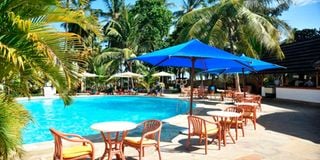Survey: Tourism shed Sh71bn under weight of Covid-19 curbs

Travellers Beach Hotel in Mombasa. The Economic Survey 2021, released by the Kenya National Bureau of Statistics (KNBS) yesterday, showed the industry’s earnings fell from Sh163.6 billion in 2019 to Sh91.7 billion in 2020.
The tourism sector shed more than Sh71 billion in 2020 under the weight of the Covid-19 containment measures, representing a 43.9 per cent decline compared to 2019.
The Economic Survey 2021, released by the Kenya National Bureau of Statistics (KNBS) yesterday, showed the industry’s earnings fell from Sh163.6 billion in 2019 to Sh91.7 billion in 2020.
Travel restrictions, social distancing measures and isolation guidelines saw international visitor arrivals drop by 71.5 per cent from 2,035,400 in 2019 to 579,600 in 2020.
“The Kenyan government suspended international passenger flights from March 25 to July 31, 2020 to contain the spread of Covid-19, which led to the decline in the number of international visitor arrivals,” the report reads in part.
The number of visitors on holiday also decreased from 1,288,900 in 2019 to 134,900 in 2020.
Similarly, the number of visitors in transit decreased by 78.5 per cent to 37,200 while those on business decreased by 37.5 per cent to 171,100 in 2020.
Visitors on holiday constituted 23.3 per cent of total international arrivals, whereas “Other” visitors and those who came to the country on business represented 40.8 per cent and 29.5 per cent of total arrivals in 2020, respectively.
According to the findings of the survey, domestic tourism was also constrained by restriction of movement of persons within the Nairobi metropolitan area and Mombasa, as well as suppression of most socio-economic activities during the second and third quarter of 2020.
In 2020, hotel bed-night occupancy contracted by 58.0 per cent to 3,803,000.
The number of international and local conferences held declined by 87 per cent and 75.2 per cent respectively.
International visitor arrivals through Jomo Kenyatta International Airport (JKIA) and Moi International Airport (MIA) sharply declined as a result of Covid-19 restrictions.
JKIA in January and February 2020 registered 13,100 and 106,400, respectively, compared to 107,000 and 107,100 during the same months in 2019.
Visitor arrivals declined to 43,300 in March 2020, when Kenya reported its first case of Covid-19 and the figures remained relatively low up to July 2020.
In the last five months of 2020, a gradual increase in visitor arrivals through JKIA was recorded, which stood at 43,200 in December.
Similarly, international visitor arrivals through MIA in January and February 2020 declined marginally to 12,200 and 11,100, compared to 15,700 and 12,900 in January and February 2019, respectively.
A decline of 63.9 per cent was recorded in March 2020 and the number of international arrivals remained low up to July 2020.
Overall, visitor arrivals through JKIA dropped by 72 per cent to 399,900 in 2020 while visitor arrivals through MIA contracted by 70.1 per cent to 34,100 during the same period.
Local conferences dropped by 75.2 per cent from 4,743 in 2019 to 1,176 in 2020 while the number of delegates attending local conferences decreased by 88.5 per cent to 80,139 in 2020.
Conference capacity utilisation declined from 12.6 per cent in 2019 to 5.2 per cent in 2020. This was because of adoption of virtual technology for conferencing in the wake of the Covid-19 pandemic.
Hotels also recorded a sharp decline in hotel bed occupancy from March to September 2020 compared to the corresponding period in 2019. This was mainly due to the measures put in place to curb the spread of Covid-19.
The number of bed-nights occupied declined by 58 per cent from 9,058,200 in 2019 to 3,803,000 in 2020.
The number of hotel bed-nights occupied by residents of Kenya decreased by 36.6 per cent to 2,567,000, accounting for 67.5 per cent of total hotel bed-nights occupied in 2020.
Figures for bed-night occupancy by continent show visitors from Europe and Asia decreased by 73.1 per cent and 84.7 per cent to 719,000 and 108,700 respectively, in 2020.
And bed-night occupancy by residents of Africa dropped by 75.4 per cent from 607, 000 in 2019 to 149,400 in 2020.
Due to the depressed arrival of visitors and Covid-19 containment measures, hotel bed occupancy rate declined from 33.8 per cent in 2019 to 17.8 per cent in 2020.
In 2020, hotel bed-nights in the Coastal Beach category decreased by 57.0 per cent to 1,502,600 and accounted for the highest proportion of total hotel bed-night occupancy at 39.5 per cent.
Over the same period, the number of hotel bed-nights in the Nairobi High Class category dropped by 59.9 per cent from 1,430,600 in 2019 to 573,700 in 2020.
In 2020, Kenyan residents dominated hotel bed-night occupancy in all areas, accounting for 56.2, 61.0 and 65.4 per cent of bed occupancy in Nairobi, Coast and Game lodges, respectively.
Residents of USA mainly preferred Nairobi and Game lodges, accounting for 7.9 per cent and 9.8 per cent of hotel bed occupancy in those areas respectively, while residents of Germany, France and other European countries preferred the Coast.
Bed-nights occupied in game lodges declined by 73.2 per cent from 939,700 in 2019 to 251,500 in 2020. The number of hotel bed-nights occupied in national parks declined by 84.0 per cent from 690,000 in 2019 to 110,200 in 2020.
Kenyan citizens constituted the largest number of visitors to national parks and game reserves.





